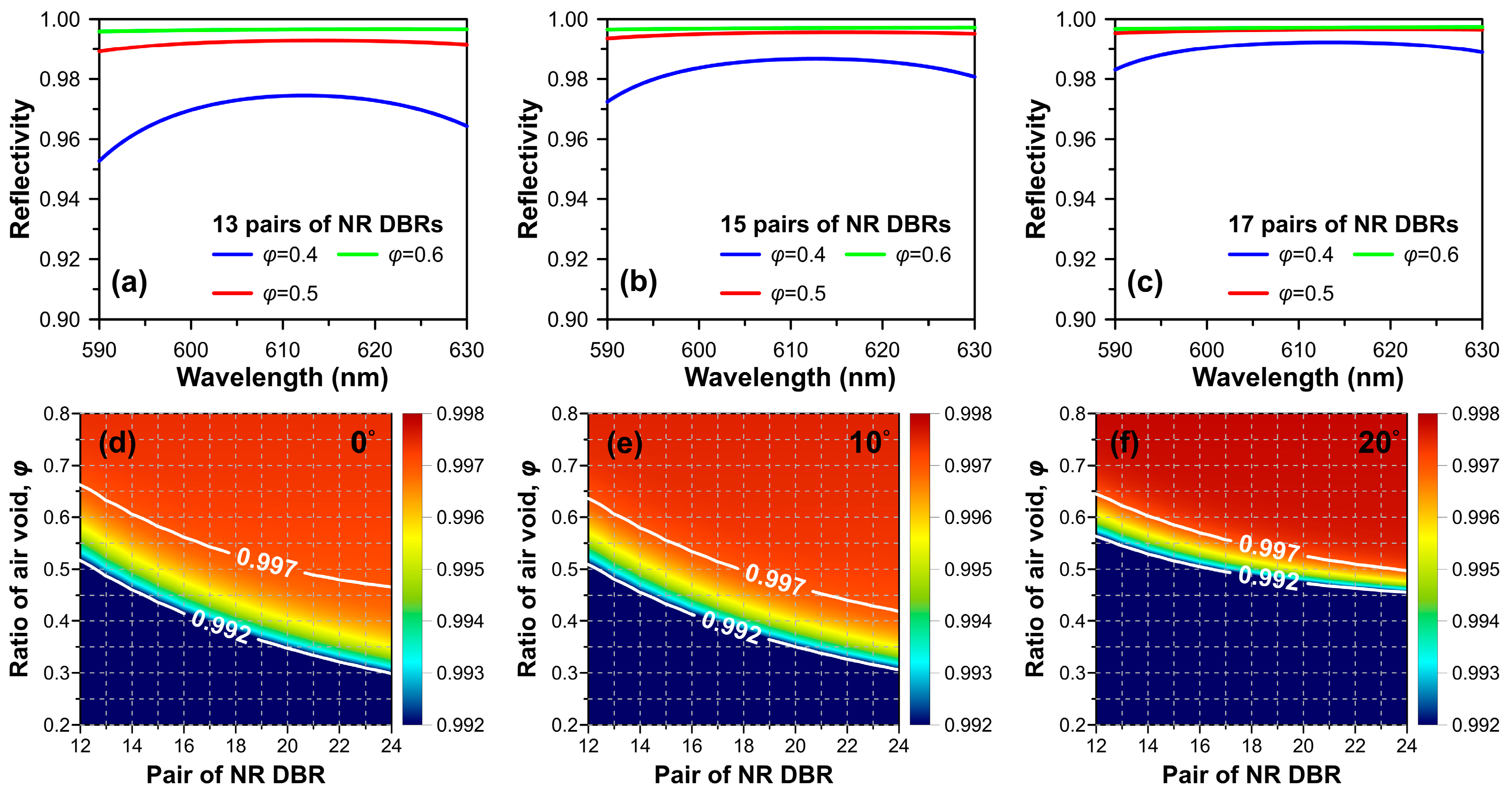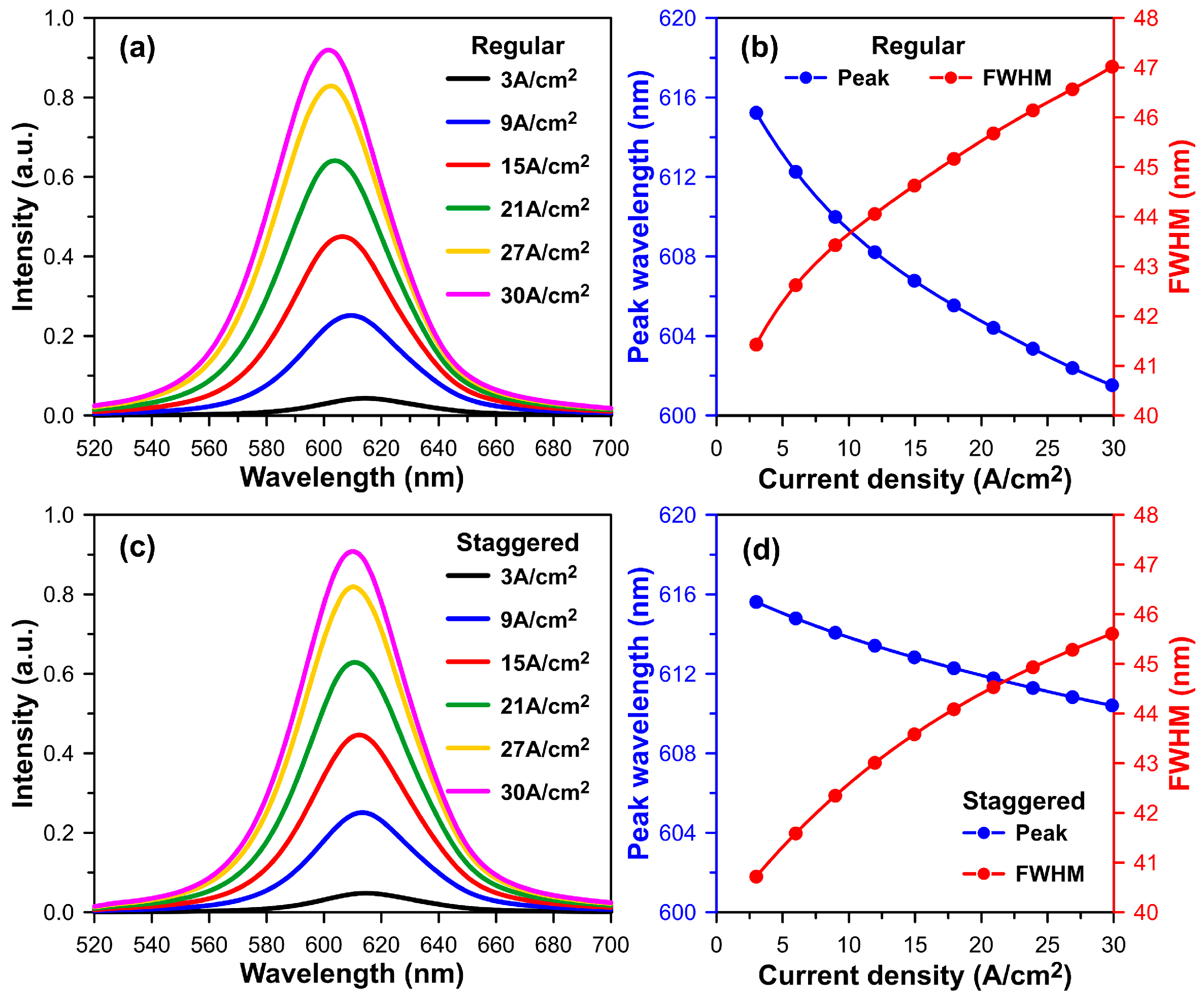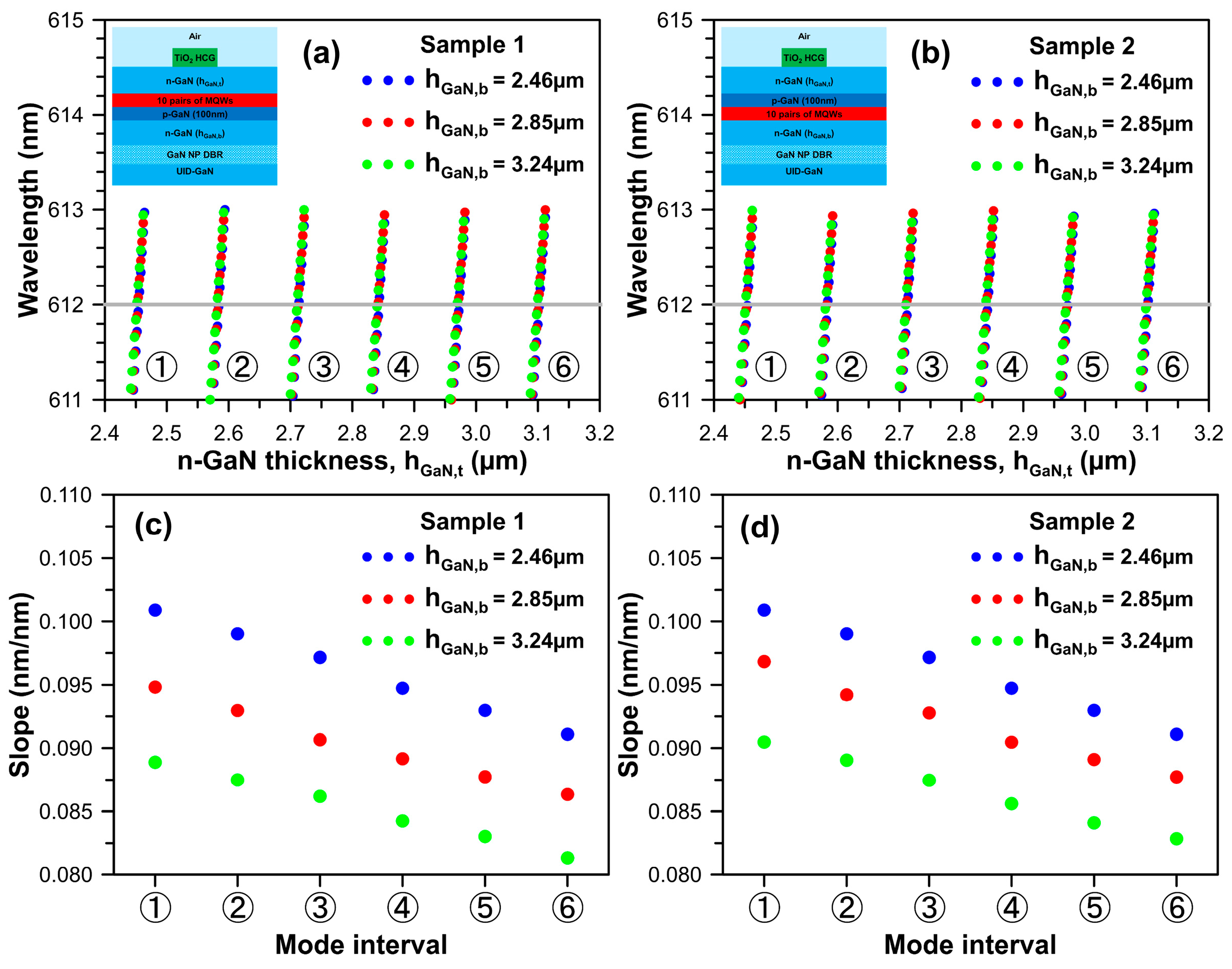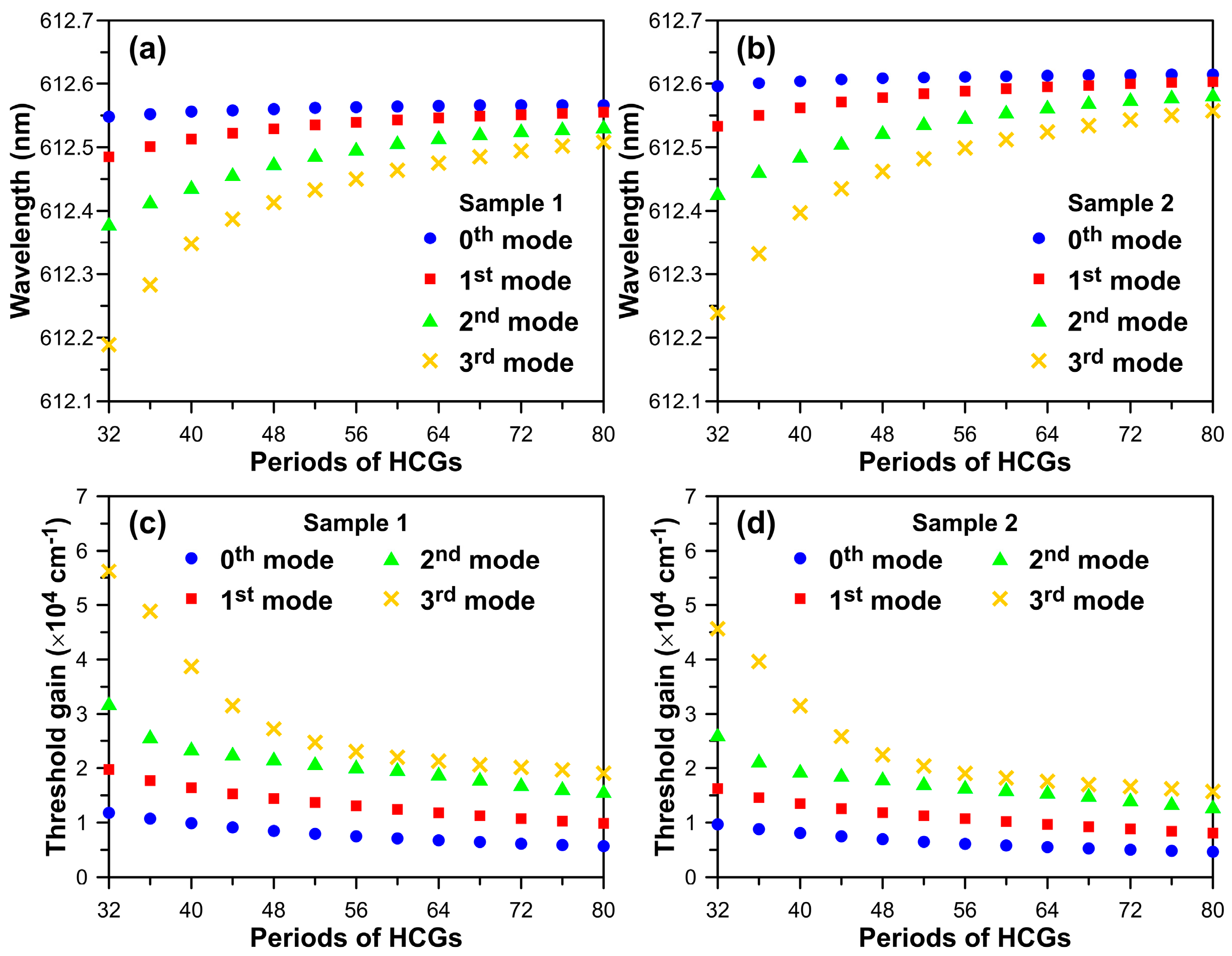Design and Simulation of InGaN-Based Red Vertical-Cavity Surface-Emitting Lasers
Abstract
:1. Introduction
2. Simulation Method
3. Results and Discussion
3.1. Selection of Nanoporous GaN DBRs
3.2. Optimization of TiO2 High-Index Contrast Grating
3.3. Staggered Multiple Quantum Well Design
3.4. Cavity Mode Wavelength of VCSEL Unit Cell Model
3.5. Threshold Gain of Finite VCSEL Model
4. Conclusions
Author Contributions
Funding
Data Availability Statement
Acknowledgments
Conflicts of Interest
References
- Chellappan, K.; Erden, V.E.; Urey, H. Laser-based displays: A review. Appl. Opt. 2010, 49, F79–F98. [Google Scholar] [CrossRef] [PubMed]
- Iga, K. Appendix G: Laser Displays and TV. In VCSEL Industry: Communication and Sensing, 1st ed.; Wiley-IEEE Press: New York, NY, USA, 2021; pp. 277–285. [Google Scholar]
- Rodes, R.; Müeller, M.; Li, B.; Estaran, J.; Jensen, J.B.; Gruendl, T.; Ortsiefer, M.; Neumeyr, C.; Rosskopf, J.; Larsen, K.J.; et al. High-speed 1550 nm VCSEL data transmission link employing 25 GBd 4-PAM modulation and hard decision forward error correction. J. Light. Technol. 2013, 31, 689–695. [Google Scholar] [CrossRef]
- Lee, M.W.; Hong, Y.; Shore, K.A. Experimental demonstration of VCSEL-based chaotic optical communications. IEEE Photon. Technol. Lett. 2004, 16, 2392–2394. [Google Scholar] [CrossRef]
- Hsiao, F.H.; Lee, T.Y.; Miao, W.C.; Pai, Y.H.; Iida, D.; Lin, C.L.; Chen, F.C.; Chow, C.W.; Lin, C.C.; Horng, R.H.; et al. Investigations on the high performance of InGaN red micro-LEDs with single quantum well for visible light communication applications. Discover Nano 2023, 18, 95. [Google Scholar] [CrossRef] [PubMed]
- Shin, H.-K.; Kim, I.; Kim, E.-J.; Kim, J.-H.; Lee, E.-K.; Lee, M.-K.; Mun, J.-K.; Park, C.-S.; Yi, Y.-S. Vertical-Cavity Surface-Emitting Lasers for Optical Data Storage. Jpn. J. Appl. Phys. 1996, 35, 506. [Google Scholar] [CrossRef]
- Martin, Y.; Rishton, S.; Wickramasinghe, H.K. Optical data storage read out at 256 Gbits/in.2. Appl. Phys. Lett. 1997, 71, 1–3. [Google Scholar] [CrossRef]
- Khan, A.; Schaefer, D.; Tao, L.; Miller, D.J.; Sun, K.; Zondlo, M.A.; Harrison, W.A.; Roscoe, B.; Lary, D.J. Power greenhouse gas sensors for unmanned aerial vehicles. Remote Sens. 2012, 4, 1355–1368. [Google Scholar] [CrossRef]
- Lan, L.; Chen, J.; Zhao, X.; Ghasemifard, H. VCSEL-based atmospheric trace gas sensor using first harmonic detection. IEEE Sens. J. 2019, 19, 4923–4931. [Google Scholar] [CrossRef]
- Sangu, S.; Shimokawa, T.; Tanaka, S. Ultracompact eye and pupil tracking device using VCSEL arrays and position sensitive detector. In Proceedings of the SPIE, Optical Architectures for Displays and Sensing in Augmented, Virtual, and Mixed Reality (AR, VR, MR), 113101F, San Francisco, CA, USA, 19 February 2020. [Google Scholar]
- Khaldi, A.; Daniel, E.; Massin, L.; Kärnfelt, C.; Ferranti, F.; Lahuec, C.; Seguin, F.; Nourrit, V.; de Bougrenet de la Tocnaye, J.-L. A laser emitting contact lens for eye tracking. Sci. Rep. 2020, 10, 14804. [Google Scholar] [CrossRef]
- Fujioka, I.; Ho, Z.; Gu, X.; Koyama, F. Solid State LiDAR with Sensing Distance of over 40 m using a VCSEL Beam Scanner. In Proceedings of the Conference on Lasers and Electro-Optics (CLEO), San Jose, CA, USA, 10–15 May 2020. [Google Scholar]
- Dummer, M.; Johnson, K.; Rothwell, S.; Tatah, K.; Hibbs-Brenner, M. The role of VCSELs in 3D sensing and LiDAR. In Proceedings of the SPIE, Optical Interconnects XXI, 116920C, San Francisco, CA, USA, 5 March 2021. [Google Scholar]
- Liu, A.; Wolf, P.; Lott, J.A.; Bimberg, D. Vertical-cavity surface-emitting lasers for data communication and sensing. Photonics Res. 2019, 7, 121–136. [Google Scholar] [CrossRef]
- Han, Y.; Li, Z.; Wu, L.; Mai, S.; Xing, X.; Fu, H.Y. High-Speed Two-Dimensional Spectral-Scanning Coherent LiDAR System Based on Tunable VCSEL. J. Light. Technol. 2023, 41, 412–419. [Google Scholar] [CrossRef]
- Chen, B.; Claus, D.; Russ, D.; Nizami, M.R. Generation of a high-resolution 3D-printed freeform collimator for VCSEL-based 3D-depth sensing. Opt. Lett. 2020, 45, 5583–5586. [Google Scholar] [CrossRef] [PubMed]
- Hamaguchi, T.; Tanaka, M.; Mitomo, J.; Nakajima, H.; Ito, M.; Ohara, M.; Kobayashi, N.; Fujii, K.; Watanabe, H.; Satou, S.; et al. Lateral optical confinement of GaN-based VCSEL using an atomically smooth monolithic curved mirror. Sci. Rep. 2018, 8, 10350. [Google Scholar] [CrossRef] [PubMed]
- Lee, S.G.; Forman, C.A.; Kearns, J.; Leonard, J.T.; Cohen, D.A.; Nakamura, S.; DenBaars, S.P. Demonstration of GaN-based vertical-cavity surface-emitting lasers with buried tunnel junction contacts. Opt. Express 2019, 27, 31621–31628. [Google Scholar] [CrossRef] [PubMed]
- Chang, T.C.; Hong, K.B.; Kuo, S.K.; Lu, T.C. Demonstration of polarization control GaN-based micro-cavity lasers using a rigid high-contrast grating reflector. Sci. Rep. 2019, 9, 13055. [Google Scholar] [CrossRef] [PubMed]
- Zheng, Z.; Mei, Y.; Long, H.; Hoo, J.; Guo, S.; Li, Q.; Ying, L.; Zheng, Z.; Zhang, B. AlGaN-based deep ultraviolet vertical-cavity surface-emitting laser. IEEE Electron Device Lett. 2021, 42, 375–378. [Google Scholar] [CrossRef]
- Hjort, F.; Enslin, J.; Cobet, M.; Bergmann, M.A.; Gustavsson, J.; Kolbe, T.; Knauer, A.; Nippert, F.; Häusler, I.; Wagner, M.R.; et al. A 310 nm Optically Pumped AlGaN Vertical-Cavity Surface-Emitting Laser. ACS Photonics 2021, 8, 135–141. [Google Scholar] [CrossRef]
- Chen, C.C.; Liaw, S.J.; Yang, Y.J. Stable Single-Mode Operation of an 850-nm VCSEL with a Higher Order Mode Absorber Formed by Shallow Zn Diffusion. IEEE Photon. Technol. Lett. 2001, 13, 266–268. [Google Scholar] [CrossRef]
- Holder, C.O.; Leonard, J.T.; Farrell, R.M.; Cohen, D.A.; Yonkee, B.; Speck, J.S.; DenBaars, S.P.; Nakamura, S.; Feezell, D.F. Nonpolar III-nitride vertical-cavity surface emitting lasers with a polarization ratio of 100% fabricated using photoelectrochemical etching. Appl. Phys. Lett. 2014, 105, 031111. [Google Scholar] [CrossRef]
- Kuramoto, M.; Kobayashi, S.; Akagi, T.; Tazawa, K.; Tanaka, K.; Saito, T.; Takeuchi, T. Enhancement of slope efficiency and output power in GaN-based vertical-cavity surface-emitting lasers with a SiO2-buried lateral index guide. Appl. Phys. Lett. 2018, 112, 111104. [Google Scholar] [CrossRef]
- Leonard, J.T.; Young, E.C.; Yonkee, B.P.; Cohen, D.A.; Margalith, T.; DenBaars, S.P.; Speck, J.S.; Nakamura, S. Demonstration of a III-nitride vertical-cavity surface-emitting laser with a III-nitride tunnel junction intracavity contact. Appl. Phys. Lett. 2015, 107, 091105. [Google Scholar] [CrossRef]
- Hamaguchi, T.; Tanaka, M.; Nakajima, H. A review on the latest progress of visible GaNbased VCSELs with lateral confinement by curved dielectric DBR reflector and boron ion implantation. Jpn. J. Appl. Phys. 2019, 58, SC0806. [Google Scholar] [CrossRef]
- Wang, Y.-C.; Yang, T.; Shi, L.; Chen, Y.-H.; Mei, Y.; Zhang, B.-P. Simulation of performance enhancement of GaN-based VCSELs by composition gradient InGaN last-quantum barrier. Semicond. Sci. Technol. 2023, 38, 125003. [Google Scholar] [CrossRef]
- Mishkat-Ul-Masabih, S.M.; Aragon, A.A.; Monavarian, M.; Luk, T.S.; Feezell, D.F. Electrically injected nonpolar GaN-based VCSELs with lattice-matched nanoporous distributed Bragg reflector mirrors. Appl. Phys. Express 2019, 12, 036504. [Google Scholar] [CrossRef]
- Elafandy, R.T.; Kang, J.-H.; Mi, C.; Kim, T.K.; Kwak, J.S.; Han, J. Study and Application of Birefringent Nanoporous GaN in the Polarization Control of Blue Vertical-Cavity Surface-Emitting Lasers. ACS Photonics 2021, 8, 1041–1047. [Google Scholar] [CrossRef]
- Horng, R.-H.; Ye, C.-X.; Chen, P.-W.; Iida, D.; Ohkawa, K.; Wu, Y.-R.; Wuu, D.-S. Study on the effect of size on InGaN red micro-LEDs. Sci. Rep. 2022, 12, 1324. [Google Scholar] [CrossRef] [PubMed]
- Chang-Hasnain, C.J.; Zhou, Y.; Huang, M.C.Y.; Chase, C. High-contrast grating VCSELs. IEEE J. Sel. Top. Quantum Electron. 2009, 15, 869–878. [Google Scholar] [CrossRef]
- Chang-Hasnain, C.J.; Yang, W. High-contrast gratings for integrated optoelectronics. Adv. Opt. Photonics 2012, 4, 379–440. [Google Scholar] [CrossRef]
- Kim, S.; Wang, Z.; Brodbeck, S.; Schneider, C.; Höfling, S.; Deng, H. Monolithic high-contrast grating based polariton laser. ACS Photonics 2019, 6, 18–22. [Google Scholar] [CrossRef]
- Gębski, M.; Lott, J.A.; Czyszanowski, T. Electrically injected VCSEL with a composite DBR and MHCG reflector. Opt. Express 2019, 27, 7139–7146. [Google Scholar] [CrossRef]
- Haglund, Å.; Hashemi, E.; Bengtsson, J.; Gustavsson, J.; Stattin, M.; Calciati, M.; Goano, M. Progress and challenges in electrically pumped GaN-based VCSELs. In Proceedings of the SPIE 9892, Semiconductor Lasers and Laser Dynamics VII, 98920Y, Brussels, Belgium, 28 April 2016. [Google Scholar]
- Hong, K.-B.; Chang, T.-C.; Hjort, F.; Lindvall, N.; Hsieh, W.-H.; Huang, W.-H.; Tsai, P.-H.; Czyszanowski, T.; Haglund, Å.; Lu, T.-C. Monolithic high-index contrast grating mirror for a GaN-based vertical-cavity surface-emitting laser. Photon. Res. 2021, 9, 2214–2221. [Google Scholar] [CrossRef]
- Czyszanowski, T.; Gebski, M.; Dems, M.; Wasiak, M.; Sarzała, R.; Panajotov, K. Subwavelength grating as both emission mirror and electrical contact for VCSELs in any material system. Sci. Rep. 2017, 7, 40348. [Google Scholar] [CrossRef] [PubMed]
- Hu, H.; Zhou, S.; Wan, H.; Liu, X.; Li, N.; Xu, H. Effect of strain relaxation on performance of InGaN/GaN green LEDs grown on 4-inch sapphire substrate with sputtered AlN nucleation layer. Sci. Rep. 2019, 9, 3447. [Google Scholar] [CrossRef] [PubMed]
- Zhuang, Z.; Iida, D.; Velazquez-Rizo, M.; Ohkawa, K. 606-nm InGaN amber micro-light-emitting diodes with an on-wafer external quantum efficiency of 0.56%. IEEE Electron Device Lett. 2021, 42, 1029–1032. [Google Scholar] [CrossRef]
- Zhuang, Z.; Iida, D.; Ohkawa, K. Investigation of InGaN-based red/green micro-light-emitting diodes. Opt. Lett. 2021, 46, 1912–1915. [Google Scholar] [CrossRef] [PubMed]
- Arif, R.A.; Zhao, H.; Ee, Y.K.; Tansu, N. Spontaneous emission and characteristics of staggered InGaN quantum-well light-emitting diodes. IEEE J. Quantum Electron. 2008, 44, 573–580. [Google Scholar] [CrossRef]
- Zhao, H.; Arif, R.A.; Tansu, N. Design analysis of staggered InGaN quantum wells light-emitting diodes at 500–540 nm. IEEE J. Sel. Top. Quantum Electron. 2009, 15, 1104–1114. [Google Scholar] [CrossRef]
- Zhang, Z.H.; Liu, W.; Ju, Z.G.; Tan, S.T.; Ji, Y.; Kyaw, Z.; Zhang, X.L.; Wang, L.C.; Sun, X.W.; Demir, H.V. Self-screening of the quantum confined stark effect by the polarization induced bulk charges in the quantum barriers. Appl. Phys. Lett. 2014, 104, 243501. [Google Scholar] [CrossRef]
- Gao, Y.; Chu, C.; Hang, S.; Zhang, Y.; Zhang, Z.-H.; Zhou, J. Quantum barriers with a polarization self-screening effect for GaN-based VCSELs to increase the electron-hole stimulated recombination and output performance. Opt. Mater. Express 2021, 11, 3984–3995. [Google Scholar] [CrossRef]
- Cai, L.-E.; Xu, C.-Z.; Xiong, F.-B.; Zhao, M.-J.; Lin, H.-F.; Lin, H.-Y.; Sun, D. Improved carrier confinement and distribution in InGaN light-emitting diodes with three-layer staggered QWs. AIP Adv. 2021, 11, 075027. [Google Scholar] [CrossRef]
- Usman, M.; Munsif, M.; Anwar, A.-R.; Mushtaq, U.; Imtiaz, W.A.; Han, D.-P.; Muhammad, N. Zigzag-shaped quantum well engineering of green light-emitting diode. Superlattices Microstruct. 2019, 132, 106164. [Google Scholar] [CrossRef]
- Gladysiewicz, M.; Hommel, D.; Kudrawiec, R. Material Gain Engineering in Staggered Polar AlGaN/AlN Quantum Wells Dedicated for Deep UV Lasers. IEEE J. Sel. Top. Quantum Electron. 2019, 25, 1901108. [Google Scholar] [CrossRef]
- Hsieh, T.-H.; Huang, W.-T.; Hong, K.-B.; Lee, T.-Y.; Bai, Y.-H.; Pai, Y.-H.; Tu, C.-C.; Huang, C.-H.; Li, Y.; Kuo, H.-C. Optoelectronic Simulations of InGaN-Based Green Micro-Resonant Cavity Light-Emitting Diodes with Staggered Multiple Quantum Wells. Crystals 2023, 13, 572. [Google Scholar] [CrossRef]
- Kivisaari, P.; Kim, I.; Suihkonen, S.; Oksanen, J. Elimination of lateral resistance and current crowding in large-area LEDs by composition grading and diffusion-driven charge transport. Adv. Electron. Mater. 2017, 3, 1700103. [Google Scholar] [CrossRef]
- Lee, M.L.; Wang, S.S.; Yeh, Y.H.; Liao, P.H.; Sheu, J.K. Light-emitting diodes with surface gallium nitride p–n homojunction structure formed by selective area regrowth. Sci. Rep. 2019, 9, 3243. [Google Scholar] [CrossRef] [PubMed]
- Davis, K.O.; Jiang, K.; Habermann, D.; Schoenfeld, W.V. Tailoring the Optical Properties of APCVD Titanium Oxide Films for All-Oxide Multilayer Antireflection Coatings. IEEE J. Photovolt. 2015, 5, 1265–1270. [Google Scholar] [CrossRef]
- Sharma, A.K.; Pandey, A.K. Self-referenced plasmonic sensor with TiO2 grating on thin Au layer: Simulated performance analysis in optical communication band. J. Opt. Soc. Am. B 2019, 36, F25–F31. [Google Scholar] [CrossRef]
- Algorri, J.F.; Morawiak, P.; Zografopoulos, D.C.; Bennis, N.; Spadlo, A.; Rodríguez-Cobo, L.; Jaroszewicz, L.R.; Sánchez-Pena, J.M.; López-Higuera, J.M. Multifunctional light beam control device by stimuli-responsive liquid crystal micro-grating structures. Sci. Rep. 2020, 10, 13806. [Google Scholar] [CrossRef]
- Hu, Y.; Zhang, Y.; Su, G.; Zhao, M.; Li, B.; Liu, Y.; Li, Z. Realization of ultrathin waveguides by elastic metagratings. Commun. Phys. 2022, 5, 62. [Google Scholar] [CrossRef]
- Zhao, G.Y.; Ishikawa, H.; Yu, G.; Egawa, T.; Watanabe, J.; Soga, T.; Jimbo, T.; Umeno, M. Thermo-optical nonlinearity of GaN grown by metalorganic chemical vapor deposition. Appl. Phys. Lett. 1998, 73, 22–24. [Google Scholar] [CrossRef]






Disclaimer/Publisher’s Note: The statements, opinions and data contained in all publications are solely those of the individual author(s) and contributor(s) and not of MDPI and/or the editor(s). MDPI and/or the editor(s) disclaim responsibility for any injury to people or property resulting from any ideas, methods, instructions or products referred to in the content. |
© 2023 by the authors. Licensee MDPI, Basel, Switzerland. This article is an open access article distributed under the terms and conditions of the Creative Commons Attribution (CC BY) license (https://creativecommons.org/licenses/by/4.0/).
Share and Cite
Yu, T.-C.; Huang, W.-T.; Wang, H.-C.; Chiu, A.-P.; Kou, C.-H.; Hong, K.-B.; Chang, S.-W.; Chow, C.-W.; Kuo, H.-C. Design and Simulation of InGaN-Based Red Vertical-Cavity Surface-Emitting Lasers. Micromachines 2024, 15, 87. https://doi.org/10.3390/mi15010087
Yu T-C, Huang W-T, Wang H-C, Chiu A-P, Kou C-H, Hong K-B, Chang S-W, Chow C-W, Kuo H-C. Design and Simulation of InGaN-Based Red Vertical-Cavity Surface-Emitting Lasers. Micromachines. 2024; 15(1):87. https://doi.org/10.3390/mi15010087
Chicago/Turabian StyleYu, Tai-Cheng, Wei-Ta Huang, Hsiang-Chen Wang, An-Ping Chiu, Chih-Hsiang Kou, Kuo-Bin Hong, Shu-Wei Chang, Chi-Wai Chow, and Hao-Chung Kuo. 2024. "Design and Simulation of InGaN-Based Red Vertical-Cavity Surface-Emitting Lasers" Micromachines 15, no. 1: 87. https://doi.org/10.3390/mi15010087
APA StyleYu, T.-C., Huang, W.-T., Wang, H.-C., Chiu, A.-P., Kou, C.-H., Hong, K.-B., Chang, S.-W., Chow, C.-W., & Kuo, H.-C. (2024). Design and Simulation of InGaN-Based Red Vertical-Cavity Surface-Emitting Lasers. Micromachines, 15(1), 87. https://doi.org/10.3390/mi15010087






